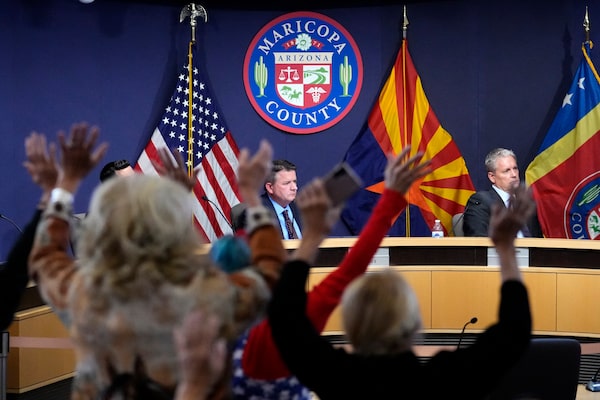
People stand in protest to the Maricopa County Board of Supervisors, Chairman Bill Gates, centre, during their general election canvass meeting, on Nov. 28, in Phoenix.Matt York/The Associated Press
Through chants of “traitor,” election officials in the Phoenix area sought to answer a litany of accusations from skeptics of what has once again become a fiercely disputed vote, one that former president Donald Trump has called “yet another criminal voting operation.”
There is no evidence for that allegation.
But Arizona’s Maricopa County, the second-largest voting district in the country, is reprising its place from 2020 as the centre of attention for those raising accusations of election fraud. A raft of technical problems plagued midterm voting on Nov. 8, when the state rejected a number of candidates closely allied with Mr. Trump.
On Monday, the county’s board of supervisors met to consider whether to certify the vote, opening the floor to hours of public comment from critics who lashed out in biblical terms, describing themselves as soldiers in a spiritual battle for the soul of America. “This is a war between good and evil and you all represent evil,” Chris Hamlet, a failed local school board candidate, said to the county supervisors. Lydia Abril, a prominent local anti-mask advocate, cited the Book of Psalms: “These men are born sinners, lying from their earliest words. They are poisonous, deadly snakes – cobras.”
Those men responded in detail, rebuffing some of the most persistent conspiracy theories while underscoring the immense complexity of democracy in the U.S. They also shed new light on the scale of printer problems, power outages and other glitches that plagued election day.
“Just because you don’t like the results of the election doesn’t mean there’s fraud and corruption,” said county supervisor Steve Gallardo, who called out Kari Lake, the gubernatorial candidate and ally of Mr. Trump who has yet to concede her loss and has already filed suit alleging election problems.
“When you have folks that are throwing rocks at the system but not wanting to tell the voters the truth – that’s unconscionable. Shame on her,” Mr. Gallardo said.
“The voters spoke, they decided,” he added. “It just happened to not be her.”
Some questions remain unaddressed, such as how many voters left queues that grew in length amid technical glitches. Critics, including some who worked at voting centres, claim hundreds of people – first responders among them – abandoned lines. “Thousands of Arizonans were disenfranchised,” Ms. Lake wrote on Twitter Monday.
She retweeted comments from the public meeting, which brought to the stage some of the country’s loudest electoral skeptics: Joe Oltmann, the Colorado podcaster who has been sued by a voting-machine company and calls himself “chief election denier”; David Clements, a former professor turned election conspiracist who has mingled with some of Mr. Trump’s closest advisers; Ben Bergquam, a correspondent for the far-right Real America’s Voice News who calls himself a “political evangelist”; and Gail Golec, a Republican rapped with a cease-and-desist order earlier this year for recommending voters steal pens from polling centres.
Many departed the room after their allotted two minutes, leaving rows of empty seats as officials then delivered a detailed response.
Statistics, they said, do not indicate large numbers of people were unable to vote. In Maricopa County, 64.2 per cent of voters cast ballots, well above average. That included 75.4 per cent of registered Republicans, slightly higher than in 2018.
Nearly 40 per cent of voting-centre locations, however, reported election day problems, just over half related to printers that applied toner too faintly to be read by electronic tabulators. As a fail-safe, voters could place those ballots in a secure box for later counting. But the snafus spawned long lines and anger.
It took hours to diagnose what went wrong and apply a fix.
At least part of the issue appears to relate to the size of the midterm ballot, which was one inch larger than in previous elections that used the same printers. Maricopa voters selected on average 85 candidates per ballot.
Officials also create different ballot styles as a fraud-prevention measure, which yields immense complexity. Maricopa County alone produces more than 12,900 different styles of ballots.
But officials rejected some allegations of malfeasance. Some voters, for example, described confusion after abandoning one polling location to cast a ballot at another. Only 206 voters went to a second location; of those, 13 second ballots were disqualified. “It was likely their first ballot had been counted at that first location,” said Scott Jarrett, director of election day and emergency voting with the county.
Similarly, officials were aware of two instances of co-mingling counted with uncounted ballots. In both cases, a recount ensured no vote was lost.
Arizona conservatives have nonetheless cried foul, saying the election was so badly executed in Maricopa County that a revote is needed. In nearby Cochise County, the Republican-dominated board of supervisors agreed Monday to delay certification.
But after a lengthy discussion, the Maricopa supervisors voted unanimously to certify, even as a woman in the audience shouted out: “We need to nullify.”
“This was not a perfect election,” board chair Bill Gates said. “But it was safe and secure. The votes have been counted accurately.”
 Nathan VanderKlippe
Nathan VanderKlippe